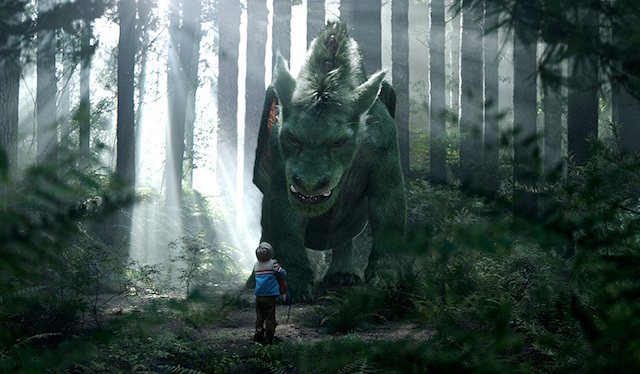'The Little Prince' And 'Pete's Dragon' Have No Time For Slavish Devotion To Source
By Chicagoist_Guest in Arts & Entertainment on Aug 12, 2016 7:44PM

The Little Prince / Netflix
By Jacob Oller
Our culture's fixation on fidelity in film adaptations—keeping things exactly like the source material—has spawned thinkpiece after thinkpiece and fostered constant scrutiny between adapted works and their sources. Have childhoods been ruined? If so, why? It allows websites to bait fans into a frothing click-frenzy, using snarky YouTube videos to highlight missed minutiae and detailed lists to catalog the most minor differences.
Two kids movies, Pete's Dragon and The Little Prince, new this week to theaters and Netflix, respectively, look to overcome this adaptive hurdle. One finds only partial success; the other soars.
Both remakes come from a place of nostalgia—which studios prefer, since an associated property means one less form of risk. Some people are pre-sold just by a name. Another Harry Potter? Sign me up. The important question is whether they can make something worthwhile within the same material.
The Little Prince novella has been adapted hundreds of times into all sorts of media—including ballet, opera and even a board game—so it seems impossible to please those focused on beat-for-beat adherence. It’s so flexible it almost has to be stretched and morphed.
The new animated adaptation expands the story into an allegory within an allegory, setting the tale of the Prince inside the heavily structured life of a nameless little girl (Mackenzie Foy). Her overbearing mother (Rachel McAdams) forces a rigorous regimen of studying and self-improvement in order to prepare her for adulthood. Their lives are filled with droopy, dour faces reminiscent of the insurance office in The Incredibles or the food critic of Ratatouille while being as strictly constructed as the brick-bound citizens of The Lego Movie.
Within its overly complex narrative, The Little Prince still finds beauty. When the little girl hears the story, we’re taken inside her imagination as it plays out. These imagined sections look like stop-motion animation made from crinkled origami, as if someone had literally built these characters from the pages of the novella. Back in the girl’s world, the characters are Pixar-like big-eyed bobbleheads, accentuated by the wacky old man next door (Jeff Bridges at his creakiest) who’s been the girl’s source for the story.
But as it weaves its themes of childhood and anxious adulthood into the already poetically nuanced source material, the film focuses too heavily on its framing devices. Moral after moral is jammed into the animation, overwhelming the relatively short story with a lengthy trip to space and a Twilight Zone version of her own world. Kids are smart enough to appreciate the foibles of adulthood when pointed out in the first ten minutes—hammering it for the next hour and a half only bores. It's a beautiful movie, but the narrative makes you work for every frame.

Pete's Dragon / Walt Disney Pictures
Pete’s Dragon, on the other side of things, strips away the bizarre ‘70s excess of the original and enhances its core, which is why it finds such success. Writer/Director David Lowery’s vision is a simplification, scaled back in narrative scope so that it toes the line between familiarity and the timeless clarity of a fable. Its nostalgia is couched in its most basic connections: a boy and his pet, a boy and his community.
The ebbs and flows of companionship and isolation begin right away, as Pete (Oakes Fegley, best when highlighting his spider monkey physicality) suffers losses but finds a dragon. The dragon, Elliott, is a tangible fuzzy green beast who shivers iridescent goosebumps when Pete grabs his fur. His interactions with the world are subtle and familiar despite being, well, a dragon. His canine face and impish wagging movements make it clear when Elliott wants to play or when he’s scared, even when he’s using his powers of invisibility. These two are the only throughlines from the original, touchstones to build a new story off of.
When other humans enter the picture, the plot elegantly conveys complexity with the vocabulary of a children’s book. It’s seemingly set in the ‘70s (at least judging by the rotary phones, musical cues and jean jackets), which only makes its plot easier to swallow—no Internet for a dragon to go viral on. But its setting, the rural forest edge, and its similarly wacky old man (Robert Redford this time, like a warm glass of Scotch) draw out nostalgia for a simpler time even from those who’ve never lived it.
The Little Prince takes its maximalist adaptation to extremes—bordering on the chaotic—to reach past its source material, but it’s fitting that in this summer of explosions, superheroes and windbags, it’s the heartfelt minimalism of Pete’s Dragon that feels essential. It’s even more impressive considering the odd disposability of the original. One children’s movie this weekend may adapt a classic, but Pete’s Dragon makes a new one.
Pete's Dragon opens everywhere on Friday. The Little Prince is available to stream now on Netflix.